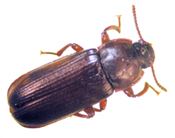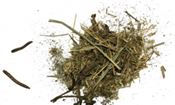Mealworms And Darkling Beetles In Hay
DR. LEE TOWNSEND
LEXINGTON, KY.
Mealworms (Figure 1) are wireworm-like larvae of darkling beetles (Figure 2). Adults and larvae feed on cracked grain kernels, fines, and processed feeds (Figure 3). They are occasional pests around feed rooms and in stored hay but can be significant pests as “litter beetles” in broiler houses. Both the adults and larvae avoid light and prefer to hide in or under things, so infestations may not be noticed until relatively large numbers of insects are present.
Consumption of a few of these insects probably does not pose a threat to cattle or horses, but responses of individual animals can vary. Ingestion of significant numbers may cause gastric distress for some animals. The mealworm life cycle from egg to adult takes about 3 months, with adults living for several months. Long-term infestations with large numbers of insects may result in significant loss of feed quality, condition, or palatability. Ultimately, the feed odor or taste may make it unacceptable.
Management
Sanitation is the key to dealing with an infestation, but darkling beetles can linger in cracks and crevices where fines collect. It is relatively easy to clean up spot infestations, but these insects can spread widely and may be present in stored bulk feed.
If a small amount of feed or grain contains only a few insects, then it may be practical to feed it out and then thoroughly clean the storage area and surroundings before refilling. A broom and shop-vac can be used to clean all accessible fines. A pyrethrins spray labeled for use in feed storage areas can be used after clean up and before new feed is added. Do not treat feed or grain directly. ∆
DR. LEE TOWNSEND: Extension Entomologist, University of Kentucky

Figure 1.

Figure 2.

Figure 3.